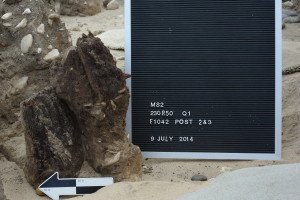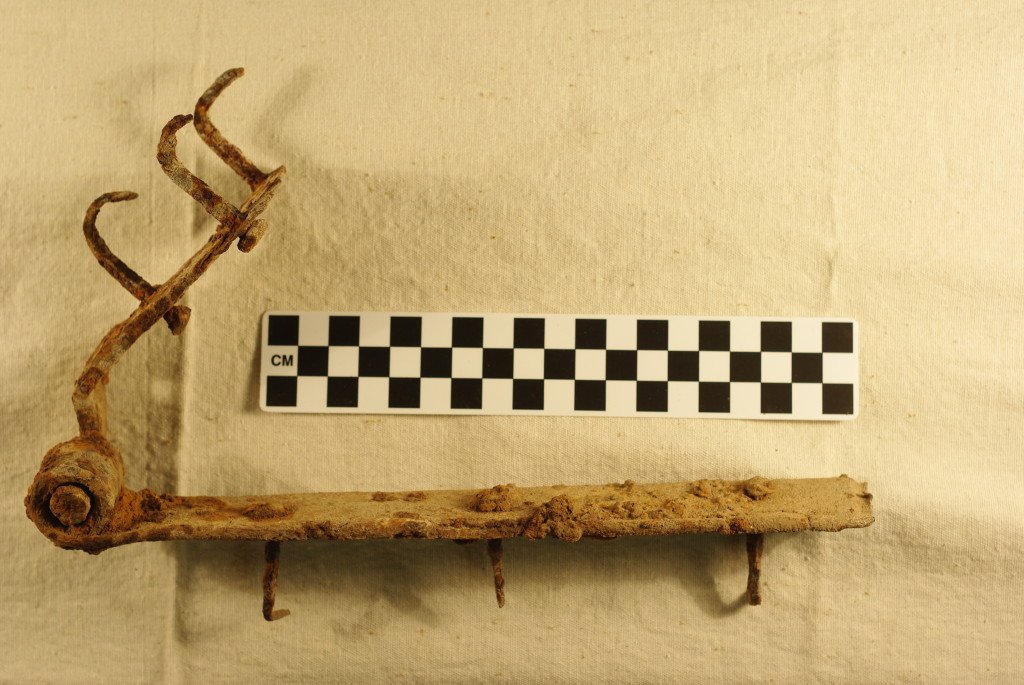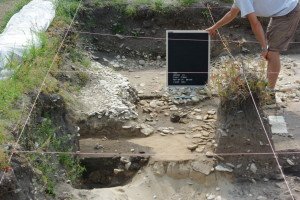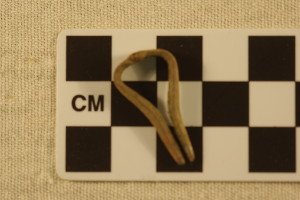Visitors to Michilimackinac get to interact with archaeologists uncovering little bits of history every day during the peak season. What they are observing is only part of the process. For every day we spend excavating, we spend two or three days in the lab trying to figure out what it all means. Following each season, a preliminary report is written, summarizing the season’s findings.
The major goal for the 2014 season was the removal of structural remains (wood posts, chinking and soil stains) associated with the south wall trench for the house. Like most of the other rowhouses at Michilimackinac, the Southeast Rowhouse was built in the poteaux-en-terre, or post-in-ground style. This is a common French-Colonial architectural style. A trench was dug and vertical posts placed into it immediately adjacent to each other. Then rocks and clay were packed around the posts to support them, and the trench was filled in. Because Michilimackinac was built on a beach, these clay and rock-filled trenches are visible, even when the posts have rotted away. Several pieces of the wall and possible supporting posts were removed last summer  . In addition to remnants of the posts, we excavated pounds of clay chinking used to fill in the gaps between the posts and also a hinge, possibly from a window shutter. All of these features and artifacts were from the British-era house, the second built on the site.
. In addition to remnants of the posts, we excavated pounds of clay chinking used to fill in the gaps between the posts and also a hinge, possibly from a window shutter. All of these features and artifacts were from the British-era house, the second built on the site.

At the west end of the excavation, remnants of the earlier, French-era south wall trench survive. These have no wood, but show up as clay-filled strips among the sand.
We also continued removing refuse pits dug into the yard of the house. Here you can see what a pit looks like in profile when it is partially removed .
.
One of the main questions we are hoping to answer by excavating this house is, what are the differences in material culture (the things people use) between a French trading household and a British trading household. The Magra map shows that an English trader lived here as early as 1765. Most English traders lived in the “subarbs” outside the fort walls. One of the most obvious differences we have seen so far is that this household has a greater number of types of ceramics than we have seen in the past three decades. Last summer was no exception, in addition to various kinds of plain and blue and white ceramics, the most common types, we found sherds of polychrome salt-glazed stoneware and polychrome creamware. Polychrome is a fancy way of saying they have multi-colored designs painted on them.
One of the other unusual artifacts we found was a tiny jaw harp  . Over two hundred jaw harps have been found at Michilimackinac, but just in the last two summers we have found two so small that only a child could have played them. Although we know that children lived at Michilimackinac it is very rare to find evidence of them in the archaeological record.
. Over two hundred jaw harps have been found at Michilimackinac, but just in the last two summers we have found two so small that only a child could have played them. Although we know that children lived at Michilimackinac it is very rare to find evidence of them in the archaeological record.









